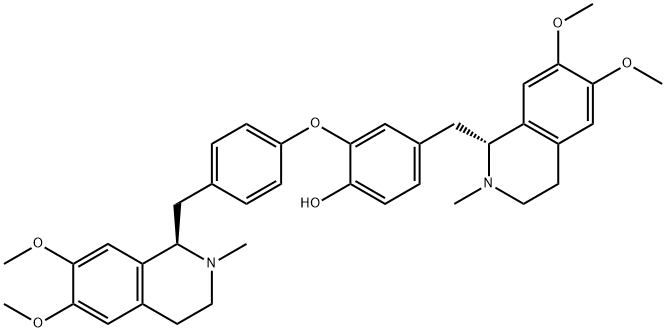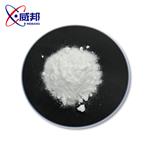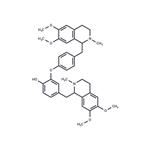Description
As a plant metabolite, Dauricine is a bioactive component derived from Asiatic Moonseed Rhizome and Canadian moonseed, which has been widely used in the treatment of a variety of inflammatory diseases especially in traditional Chinese medicine. It was first synthesized by the scientists from Japan in 1964.
It has been proved that Dauricine plays a number of biological roles in the human body, from inhibiting cancer cell growth to blocking cardiac transmembrane Na+, K+, and Ca2+ ion currents. Recent studies suggested that there is novel role of dauricine in preventing or treating cancer. It has been shown to have anti-tumor effects in several cancers, including colon cancer, breast cancer, urinary cancers such as bladder cancer and prostate cancer.
References
https://en.wikipedia.org/wiki/Dauricine
https://www.ncbi.nlm.nih.gov/pubmed/20509140
Description
Dauricine is a kind of phenolic aromatic compound which is isolated from
Menispermaceae plants such as Asian Menispermum dauricum or Canadian
Menispermum dauricum and can be classified as isoquinoline alkaloids.
Rhizoma Menispermi is the dry rhizome of Menispermaceae plant Menispermum
dauricum. Menispermum dauricum mainly distributes in the northern part of East
Asia and is mainly distributed in the north, east and northeast regions of China. The
usage of Rhizoma Menispermi as a kind of traditional Chinese medicine was firstly
recorded in Kaibao Herbs with its function of detoxifying many drugs, relieving
pains, reducing swelling and sore, curing fever and cough, and killing parasites.
According to the Chinese Pharmacopoeia, Rhizoma Menispermi in the north of
China is different from the herbs used in the south of China known as the same
name. Based on the traditional Chinese Medicine theory, Rhizoma Menispermi has
the feature of bitterness and coldness, with the meridian tropism in the lung, stomach,
and intestine. The main effects of Rhizoma Menispermi are heat-clearing,
detoxicating, wind-dispelling and pain-relieving according to its vital function lies
in the therapy of swollen sore throat, enteritis diarrhea and rheumatic arthralgia.
Alkaloid is the main chemical component of Rhizoma Menispermi, and besides
dauricine, there are also other kinds of alkaloids such as dauriciline,
O-methyldauricine, and daurisoline in it.
Physical properties
Appearance: yellowish-white powder or crystal. Solubility: soluble in ethanol,
methanol, chloroform, acetone, benzene and slightly soluble in ether. Density:
1.185 g/cm3. Melting point: 115 °C. Boiling point: 712.3 °C at 760 mmHg atmospheric
pressure. Specific optical rotation: MeOH-139.
History
Menispermum dauricum has been long used as a traditional Chinese medicine, but
the research of its effective components has been slow. Dauricine was firstly separated
and structure-confirmed by Fukuda Mayo using alumina column chromatography
separation assay in 1964. At the same year, dauricine was first synthesized
by two Japanese scientists, Tetsuji Tamayama and Rtani Rikazu, by means of Arndt-Eistert
reaction and Bischler-Napieralski reaction. Thereafter, lots of scientists
from various countries successively separated daurinoline, Menispermum Xinlin
alkali, Menispermum succinylcholine alkali, chelilanthifoline, stepholidine, and
many other monomeric components of Menispermum dauricum.
The study of dauricine in China started from the Cultural Revolution Period.
Under the guidance of integrated traditional Chinese and Western medicine, a large
number of effective components in traditional Chinese herbs were extracted, separated
and applied to clinic. Dauricine was firstly reported on the mainland as an
active ingredient in herbs which can clear away heat and toxic materials. Moreover,
dauricine was also used as an antineoplastic and muscle relaxant. There were many
medicines whose principal component was dauricine had been under clinical
research for its role of cardiovascular protection since the 1980s, most of these
medicines were stagnating in phase II clinical trials.
Uses
Dauricine is a bisbenzylisoquinoline allkaloid derivative that displays a noted number of pharmaceutical properties. It is known to induces severe lung toxicity in animals.
Indications
Drugs whose main component is dauricine are still in clinical trials. Several formulations of dauricine have currently been developed, including tablets, capsules,
injections, and so on. The main indications of dauricine in clinical trials are antiplatelet,antihypertensive and anti-arrhythmic.
Definition
ChEBI: A bisbenzylisoquinoline alkaloid resulting from the formal oxidative dimerisation of 4-{[(1R)-6,7-dimethoxy-2-methyl-1,2,3,4-tetrahydroisoquinolin-1-yl]methyl}phenol by attachment of the phenolic oxygen of one molecule to the benzene ring
f the second (ortho to the phenolic hydroxy group of the latter).
Pharmacology
The main pharmacological actions of dauricine are as follows;
Anti-arrhythmia: Dauricine can slow the heart rate and prolong conduction time in
sinus rhythm, therefore reducing the incidence of arrhythmia.
Anti-myocardial ischemia: Dauricine has protective effect on myocardial ischemia
and can improve hemodynamic disturbances during ischemia which is supposed
to produce effect via mechanism of improving myocardial metabolism and
anti-oxidation.
Anti-cerebral ischemia: Dauricine has an effective regulation on gene expression of
Bcl-2 and Bax in cortical neurons after the ischemic brain injury, protecting
against cerebral ischemia.
Anti-cerebral ischemia/reperfusion injury: Dauricine can inhibit apoptosis induced
by cerebral ischemia/reperfusion injury by upregulating Bcl-2 expression and
downregulating Bax expression. Also dauricine has the effect of anti-oxidation.
Antitumor activity: Dauricine can affect TGF-beta signaling pathway via upregulating
gene expression of DPC4, and then the gene expression of P53 and P16 in
tumor tissue, and finally reduce the gene expression of hFGF in tumor tissue.
Thereby, the growth of various tumor cells could be inhibited.
The investigations of metabolism in vivo of dauricine indicate that it is rapidly
and widely distributed in body and the drug concentration in organs is significantly
higher than that in plasma, and this is possibly related to its strong lipid solubility
and easy access to cells.
Clinical Use
No medicine in the market takes dauricine as the main component up till now. Many
animal experiments and clinical studies suggest that dauricine can reverse the effect
of MDR as verapamil. Since the clinical application of the classical drug verapamil
is limited for the serious toxic side effects, the moderate pharmacological effect of
dauricine has a vital clinical significance. The main side effect of dauricine by oral
absorption is gastrointestinal reaction, such as diarrhea, nausea, abdominal distension,
and so on. In addition, dauricine can accumulate in the body, leading to hepatorenal
toxicity and central nervous system toxicity.



